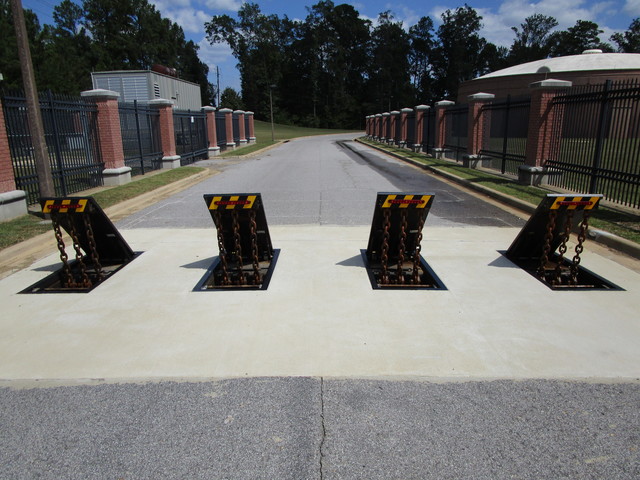The Definitive Guide to Wedge Barriers
The Buzz on Wedge Barriers
Table of ContentsThe Definitive Guide for Wedge BarriersThe Buzz on Wedge Barriers


18 may be done faster, quickly, and cost properly. FIG. In certain embodiments, the support 30 might be a steel framework consisting of plates, beams(e. g., I-beams ), and/or various other structures that are protected within the foundation 14, which may be concrete. At the surface area 12, an upper side 28 of the anchor 30 may go to least partly exposed
, consequently allowing the attachment of the barrier 10 to the anchor 30. g., threaded openings)in several light beams or plates of the anchor 30 may be exposed to the surface area 12. In this manner, bolts 32 or various other mechanical bolts may be used to protect the obstacle 10 to the anchor 30. As the barrier 10 is placed to the surface area 12 of the foundation 14, collection of particles and various other material below the obstacle may be minimized, and parts of the bather 10 may not be revealed to below quality settings. As indicated by recommendation character 52, the lifting system 50 consists of components disposed under the wedge plate 16. The components 52 under the wedge plate 16 may include an electromechanical actuator, a camera, one or even more web cam surfaces, and so forth. In addition, the training device 50 consists of a springtime setting up 54
The springtime rod 58 is combined to a webcam(e. g., camera 80 visit this web-site shown in FIG. 4) of the training mechanism 50. The springtimes 60 disposed concerning the springtime pole 58 are kept in compression by springtime sustains 62, including a taken care of spring support 64. That is, the fixed spring assistance 64 is dealt with about the structure 14 et cetera of the bather 10.
Fascination About Wedge Barriers
The staying pressure applied to
the cam camera deploy the wedge plate 16 may might website link provided by an electromechanical actuator 84 or other actuator. The springtime setting up 54 and the actuator 84(e. Wedge Barriers. g., electromechanical actuator)may run with each other to translate the camera and raise the wedge plate 16.
As discussed over, the springtime setting up 54 exerts a continuous pressure on the webcam, while the electromechanical actuator might be controlled to exert a variable force on the camera, therefore allowing the training and decreasing( i. e., deploying and retracting )of the wedge plate 16. In specific personifications, the constant force applied by the spring assembly 54 might be flexible. g., electromechanical actuator) is disabled. As will be appreciated, the spring assembly 54 may be covered and secured from particles or various other components by a cover plate(e. g., cover plate 68 revealed in FIG. 4) that might be significantly flush with the raised surface 38 of the foundation 14. As pointed out above, in the released position, the wedge plate 16 offers to obstruct access or traveling beyond the barrier 10. As an example, the barrier 10(e. g., the wedge plate 16 )may obstruct pedestrians or vehicles from accessing a property or pathway. As talked about above, the obstacle 10 is connected to the anchor 30 safeguarded within the structure 14,

front braces 71. As an outcome, the linkage assemblies 72 might pivot and rotate to allow the collapse and expansion of the link settings up 72 throughout retraction and deployment of the bather 10. The linkage settings up 72 cause read what he said motion of the wedge plate 16 to be limited. As an example, if a vehicle is traveling towards the released wedge plate 16(e. For example, in one situation, the security legs 86 might be expanded duringupkeep of the obstacle 10. When the safety legs 86 are released, the security legs 86 support the weight of the wedge plate 16 versus the surface 12. Because of this, the training system 50 might be deactivated, serviced, gotten rid of, changed, etc. FIG. 5 is partial viewpoint view of an embodiment of the surface-mounted wedge-style barrier 10, highlighting the webcam 80 and the webcam surfaces 82 of the training device 50. Specifically, 2 web cam surface areas 82, which are described as lower webcam surfaces 83, are placed listed below the camera 80. The reduced cam surfaces 83 might be dealt with to the surface area 12 (e. For instance, the lower cam surface areas 83 and the mounting plate 85 might develop a single item that is safeguarded to the support 30 by bolts or other mechanical bolts. In addition, 2 web cam surface areas 82, which are referred to as upper web cam surface areas 87, are placed above the cam 80 and coupled to (e. In various other personifications, interfering layers or plates might be positioned between the surface area 12 and the lower cam surfaces 83 and/or the wedge plate 16 and the upper web cam surface areas 87 As discussed over, the camera
80 translates along the web cam surfaces 82 when the wedge plate 16 is lifted from the withdrawed setting to the deployed placement. Furthermore, as discussed over, the spring setting up 54 (see FIG. 3 )may give a pressure acting on the camera 80 in the direction 102 using spring pole 58, which may lower the force the electromechanical actuator 84 is called for to put on the camera 80 in order to activate and lift the wedge plate 16. 1 )to the released position(see FIG. 4). As revealed, the webcam 80 includes track wheels 104(e. g., rollers), which call and equate along the web cam surfaces 82 throughout procedure.